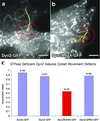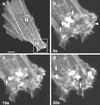The large GTPase dynamin regulates actin comet formation and movement in living cells
- PMID: 11782546
- PMCID: PMC117533
- DOI: 10.1073/pnas.012607899
The large GTPase dynamin regulates actin comet formation and movement in living cells
Abstract
The large GTPase dynamin (Dyn2) has been demonstrated by us and others to interact with several different actin-binding proteins. To define how Dyn2 might participate in actin dynamics in livings cells we have expressed green fluorescent protein (GFP)-tagged Dyn2 in cultured cells and observed labeling of comet-like vesicles and macropinosomes. The comet structures progressed with a constant velocity and were reminiscent of actin comets associated with motile vesicles in cells expressing type I phosphatidylinositol phosphate 5-kinases. Based on these observations we sought to determine whether Dyn2 is an integral component of actin comets. Cells expressing type I phosphatidylinositol phosphate 5-kinase and Dyn2-GFP revealed a prominent colocalization of Dyn2 and actin in comet structures. Interestingly, comet formation and motility were normal in cells expressing wild-type Dyn2-GFP but altered markedly in Dyn2 mutant-expressing cells. Dyn2K44A-GFP mutant cells displayed a significant reduction in comet number, length, velocity, and efficiency of movement. In contrast, comets in cells expressing Dyn2DeltaPRD-GFP appeared dark and did not incorporate the mutant Dyn2 protein, indicating that the proline-rich domain (PRD) is required for Dyn2 recruitment. Further, these comets were significantly longer and slower than those in control cells. These findings demonstrate a role for Dyn2 in actin-based vesicle motility.
Figures






References
-
- McNiven M A, Cao H, Pitts K R, Yoon Y. Trends Biochem Sci. 2000;25:115–120. - PubMed
Publication types
MeSH terms
Substances
LinkOut - more resources
Full Text Sources
Miscellaneous

